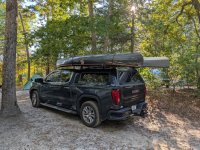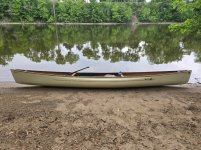what I was trying to ask is whether boats like the Cirrus and YS solo would be equally as maneuverable as a WildFIRE when heeled - does the heel remove the straight-tracking enough to make the heeled Cirrus equal in maneuverability to a WildFIRE?
I take it you are asking about heeling from a centralized solo seat. I'll make some points, probably repeating what others have said.
1. Any canoe I've ever paddled will turn better when heeled. Heeling shortens the waterline and can pull the stern stem out of the water. If the stern stem is lifted far enough, there will be a "crack" between the water and the heeled stern stem. Some paddlers talk about "cracking" the stern to make turns.
2. Pitching the bow down will further shorten the waterline and increase the stern crack, thereby enhancing turns.
3. I have had a composite black-gold Bell Wildfire, which has symmetrical rocker, for 16 years and have also paddled the Royalex Bell Yellowstone (initially also called a Wildfire), which has asymmetrical rocker. The composite Wildfire turns somewhat better both unheeled and heeled. For one reason, the stern will crack more with the composite Wildfire's symmetrical rocker. However, the Yellowstone turns sufficiently well for just about any practical need.
4. I've never seen the new Swift Cirrus and haven't yet heard an informed review of it.
5. The turnability of a heeled canoe is also affected by the shape of the sides—how full the sides are, and how the fullness is carried along the length of the sides. I've paddled three canoes that turn significantly better than I expected from looking at their rockerlines, in all cases because of the "pivotability" of their side fullness.
Mike Galt's Lotus Caper, designed in 1982 or so, has almost no rocker. Yet, it can be free-spinned when heeled by a paddler below about 165 pounds. That's because Galt carried side fullness behind the paddling station and pinched the stern cheeks. These factors create a big stern crack when the hull is heeled, and hence easy turnability. Yet the canoe tracks firmly on its negligible rockerline when unheeled.
Nolan Whitesell designed his legendary whitewater canoe, the Piranha, with what he called "pivoting bulges" on the central sides of the canoe. As he put it, "I believe in side rocker." All whitewater canoeists turn soft-chine canoes with heels to the rail, and hence Nolan enhanced turnability with side fullness rather than radical rocker.
Just this past week I paddled a Savage River Illusion, which never appeared to me to be particularly turnable by looking at the rockerline of the hull. I was literally shocked at to how turnable it is, and I attribute some of that to well-placed side fullness, as well as to modest rocker and a short waterline. It has a shorter waterline than a Wildfire, and I now give it the edge over my Wildfire in both turnability and acceleratability. You can see the side fullness of the Illusion in this picture.

6. Tracking straight in any solo touring hull is much more a function of a paddler's stick skills than an a decreased inch of asymmetrical stern rocker. Just as pitching a touring hull forward will enhance turnability by pinning the bow and loosening the stern, you can modestly "skeg" the stern of a solo canoe by trimming it a bit stern heavy via a sliding seat or by putting a gear bag in the stern.




